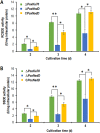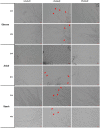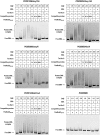Transcription Factor NsdD Regulates the Expression of Genes Involved in Plant Biomass-Degrading Enzymes, Conidiation, and Pigment Biosynthesis in Penicillium oxalicum
- PMID: 29980558
- PMCID: PMC6121985
- DOI: 10.1128/AEM.01039-18
Transcription Factor NsdD Regulates the Expression of Genes Involved in Plant Biomass-Degrading Enzymes, Conidiation, and Pigment Biosynthesis in Penicillium oxalicum
Abstract
Soil fungi produce a wide range of chemical compounds and enzymes with potential for applications in medicine and biotechnology. Cellular processes in soil fungi are highly dependent on the regulation under environmentally induced stress, but most of the underlying mechanisms remain unclear. Previous work identified a key GATA-type transcription factor, Penicillium oxalicum NsdD (PoxNsdD; also called POX08415), that regulates the expression of cellulase and xylanase genes in P. oxalicum PoxNsdD shares 57 to 64% identity with the key activator NsdD, involved in asexual development in Aspergillus In the present study, the regulatory roles of PoxNsdD in P. oxalicum were further explored. Comparative transcriptomic profiling revealed that PoxNsdD regulates major genes involved in starch, cellulose, and hemicellulose degradation, as well as conidiation and pigment biosynthesis. Subsequent experiments confirmed that a ΔPoxNsdD strain lost 43.9 to 78.8% of starch-digesting enzyme activity when grown on soluble corn starch, and it produced 54.9 to 146.0% more conidia than the ΔPoxKu70 parental strain. During cultivation, ΔPoxNsdD cultures changed color, from pale orange to brick red, while the ΔPoxKu70 cultures remained bluish white. Real-time quantitative reverse transcription-PCR showed that PoxNsdD dynamically regulated the expression of a glucoamylase gene (POX01356/Amy15A), an α-amylase gene (POX09352/Amy13A), and a regulatory gene (POX03890/amyR), as well as a polyketide synthase gene (POX01430/alb1/wA) for yellow pigment biosynthesis and a conidiation-regulated gene (POX06534/brlA). Moreover, in vitro binding experiments showed that PoxNsdD bound the promoter regions of the above-described genes. This work provides novel insights into the regulatory mechanisms of fungal cellular processes and may assist in genetic engineering of Poxalicum for potential industrial and medical applications.IMPORTANCE Most filamentous fungi produce a vast number of extracellular enzymes that are used commercially for biorefineries of plant biomass to produce biofuels and value-added chemicals, which might promote the transition to a more environmentally friendly economy. The expression of these extracellular enzyme genes is tightly controlled at the transcriptional level, which limits their yields. Hitherto our understanding of the regulation of expression of plant biomass-degrading enzyme genes in filamentous fungi has been rather limited. In the present study, regulatory roles of a key regulator, PoxNsdD, were further explored in the soil fungus Penicillium oxalicum, contributing to the understanding of gene regulation in filamentous fungi and revealing the biotechnological potential of Poxalicum via genetic engineering.
Keywords: Penicillium oxalicum; PoxNsdD; conidiation; pigment biosynthesis; starch-degrading enzyme; transcription factor.
Copyright © 2018 American Society for Microbiology.
Figures








Similar articles
-
Transcription Factor Atf1 Regulates Expression of Cellulase and Xylanase Genes during Solid-State Fermentation of Ascomycetes.Appl Environ Microbiol. 2019 Nov 27;85(24):e01226-19. doi: 10.1128/AEM.01226-19. Print 2019 Dec 15. Appl Environ Microbiol. 2019. PMID: 31604764 Free PMC article.
-
Novel Transcription Factor CXRD Regulates Cellulase and Xylanase Biosynthesis in Penicillium oxalicum under Solid-State Fermentation.Appl Environ Microbiol. 2023 Jun 28;89(6):e0036023. doi: 10.1128/aem.00360-23. Epub 2023 May 16. Appl Environ Microbiol. 2023. PMID: 37191516 Free PMC article.
-
Transcriptomic profiling and genetic analyses reveal novel key regulators of cellulase and xylanase gene expression in Penicillium oxalicum.Biotechnol Biofuels. 2017 Nov 22;10:279. doi: 10.1186/s13068-017-0966-y. eCollection 2017. Biotechnol Biofuels. 2017. PMID: 29201143 Free PMC article.
-
Every road leads to Rome: diverse biosynthetic regulation of plant cell wall-degrading enzymes in filamentous fungi Penicillium oxalicum and Trichoderma reesei.Crit Rev Biotechnol. 2024 Nov;44(7):1241-1261. doi: 10.1080/07388551.2023.2280810. Epub 2023 Nov 30. Crit Rev Biotechnol. 2024. PMID: 38035670 Review.
-
Improvement of cellulolytic enzyme production and performance by rational designing expression regulatory network and enzyme system composition.Bioresour Technol. 2017 Dec;245(Pt B):1718-1726. doi: 10.1016/j.biortech.2017.06.120. Epub 2017 Jun 23. Bioresour Technol. 2017. PMID: 28684177 Review.
Cited by
-
Characterization and engineering of the xylose-inducible xylP promoter for use in mold fungal species.Metab Eng Commun. 2022 Nov 19;15:e00214. doi: 10.1016/j.mec.2022.e00214. eCollection 2022 Dec. Metab Eng Commun. 2022. PMID: 36452447 Free PMC article.
-
Identification of an essential regulator controlling the production of raw-starch-digesting glucoamylase in Penicillium oxalicum.Biotechnol Biofuels. 2019 Jan 4;12:7. doi: 10.1186/s13068-018-1345-z. eCollection 2019. Biotechnol Biofuels. 2019. PMID: 30622649 Free PMC article.
-
A Global Analysis of Photoreceptor-Mediated Transcriptional Changes Reveals the Intricate Relationship Between Central Metabolism and DNA Repair in the Filamentous Fungus Trichoderma atroviride.Front Microbiol. 2021 Sep 8;12:724676. doi: 10.3389/fmicb.2021.724676. eCollection 2021. Front Microbiol. 2021. PMID: 34566928 Free PMC article.
-
Gene Regulatory Networks of Penicillium echinulatum 2HH and Penicillium oxalicum 114-2 Inferred by a Computational Biology Approach.Front Microbiol. 2020 Oct 27;11:588263. doi: 10.3389/fmicb.2020.588263. eCollection 2020. Front Microbiol. 2020. PMID: 33193246 Free PMC article.
-
Functional Characterization of the GATA-Type Transcription Factor PaNsdD in the Filamentous Fungus Podospora anserina and Its Interplay with the Sterigmatocystin Pathway.Appl Environ Microbiol. 2022 Mar 22;88(6):e0237821. doi: 10.1128/aem.02378-21. Epub 2022 Jan 26. Appl Environ Microbiol. 2022. PMID: 35080910 Free PMC article.
References
Publication types
MeSH terms
Substances
LinkOut - more resources
Full Text Sources
Other Literature Sources

